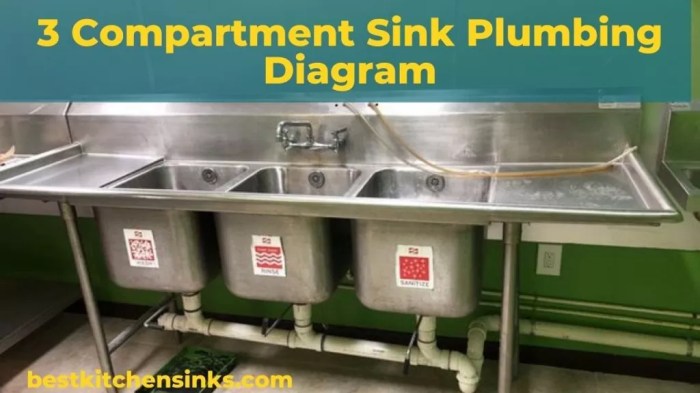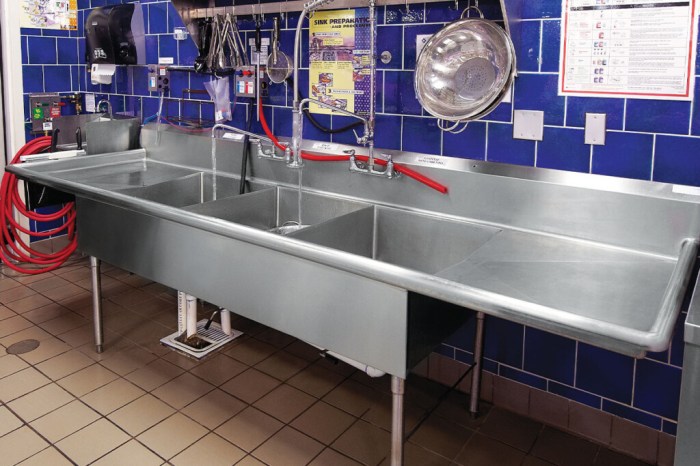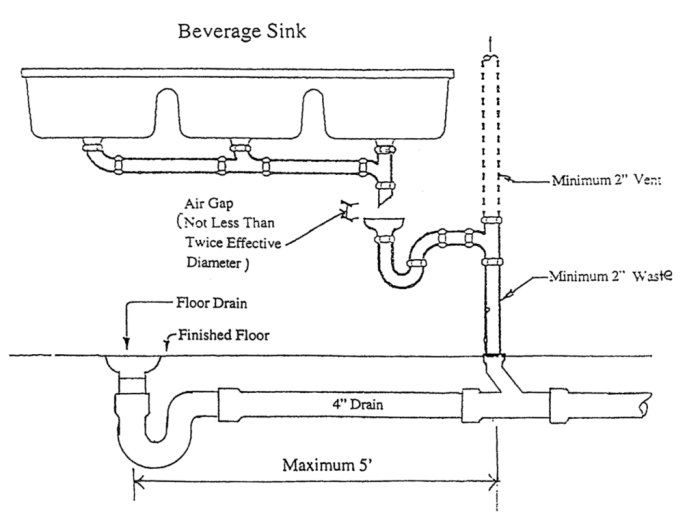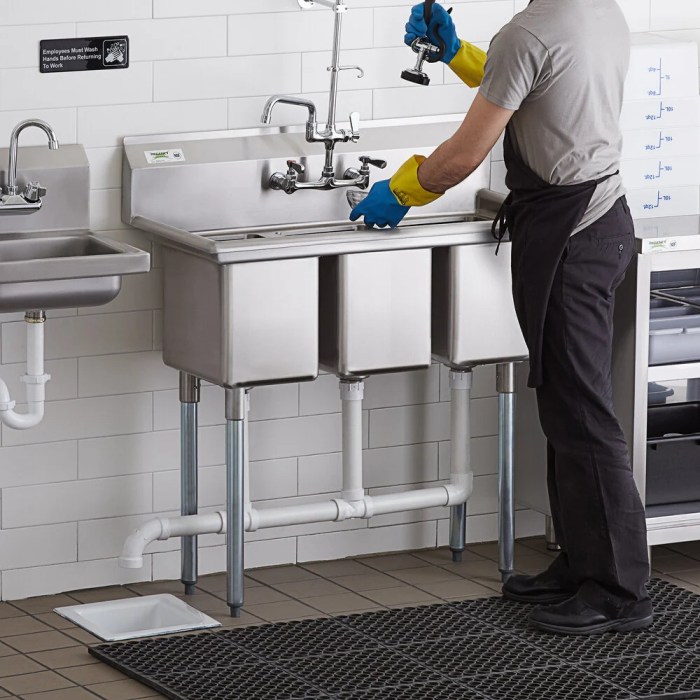Introducing the air gap 3 compartment sink, an indispensable tool in commercial and residential kitchens. Its unique design and features provide unparalleled hygiene and efficiency, making it a must-have for maintaining a clean and functional workspace. In this comprehensive guide, we’ll delve into the intricacies of air gap 3 compartment sinks, exploring their benefits, applications, and everything you need to know.
From understanding the purpose of an air gap to selecting the most suitable model for your needs, this guide will empower you with the knowledge to make informed decisions. So, let’s dive right in and uncover the world of air gap 3 compartment sinks.
Design Features of an Air Gap 3 Compartment Sink

An air gap in a 3 compartment sink is a crucial design feature that prevents backflow of contaminated water into the clean water supply. It ensures the safety and hygiene of the sink, particularly in commercial kitchens and food preparation areas.
An air gap 3 compartment sink typically consists of three separate basins, each with its own drain and faucet. The air gap is a small space between the end of the faucet spout and the rim of the sink. This gap allows air to enter the drainpipe, breaking the siphon and preventing contaminated water from being drawn back into the clean water supply.
Materials
Air gap 3 compartment sinks are typically made of stainless steel or cast iron. Stainless steel is a durable and corrosion-resistant material, making it ideal for commercial kitchens and other high-traffic areas. Cast iron is also durable, but it is heavier and more prone to rust than stainless steel.
Dimensions
The dimensions of an air gap 3 compartment sink vary depending on the manufacturer and the specific model. However, the overall length of the sink is typically around 60 to 72 inches, and the width is around 24 to 30 inches.
The depth of the basins is typically around 10 to 12 inches.
If you’re in the market for an air gap 3 compartment sink, you’ll want to make sure you get the right size. To do that, you’ll need to find the measure of yvz. Find the measure of yvz is a simple process that can be done with a few basic tools.
Once you have the measure of yvz, you can easily find the right size air gap 3 compartment sink for your needs.
Configurations
Air gap 3 compartment sinks are available in a variety of configurations to meet different needs. Some sinks have a single faucet with a spray hose, while others have separate faucets for hot and cold water. Some sinks also have a built-in soap dispenser or a garbage disposal.
Advantages and Disadvantages of Different Materials
Stainless steel is the most popular material for air gap 3 compartment sinks due to its durability and corrosion resistance. However, stainless steel sinks can be more expensive than cast iron sinks.
Cast iron sinks are less expensive than stainless steel sinks, but they are heavier and more prone to rust. Cast iron sinks also require more maintenance than stainless steel sinks.
Installation and Maintenance of an Air Gap 3 Compartment Sink

Installing and maintaining an air gap 3 compartment sink is crucial for its optimal performance. Proper installation ensures a hygienic and efficient operation, while regular maintenance prevents issues and extends the sink’s lifespan.
Step-by-Step Installation Guide
1.
-
-*Choose the Right Location
Determine the sink’s placement considering plumbing access, countertop space, and overall kitchen layout.
- 2.
- 3.
- 4.
- 5.
- 6.
- 7.
-*Prepare the Countertop
Cut the appropriate hole in the countertop according to the sink’s template.
-*Install the Drain Assembly
Connect the drain assembly to the sink’s drain holes. Ensure a snug fit using plumbers’ putty or a gasket.
-*Attach the Air Gap
Mount the air gap on the countertop, above the sink. Connect the air gap to the dishwasher’s drain line using flexible tubing.
-*Secure the Sink
Place the sink into the countertop hole and secure it using mounting brackets or clips.
-*Connect the Plumbing
Connect the sink’s hot and cold water supply lines to the respective valves. Tighten all connections securely.
-*Test for Leaks
Turn on the water supply and check for any leaks around the sink, drain, and air gap connections.
Applications of an Air Gap 3 Compartment Sink

Air gap 3 compartment sinks are highly versatile and find applications in various commercial and residential settings. Their unique design offers several benefits, making them ideal for maintaining hygiene and efficiency in different environments.
Commercial Applications
In commercial kitchens, air gap 3 compartment sinks are commonly used for:
- Dishwashing:The compartments allow for separate washing, rinsing, and sanitizing stages, ensuring thorough cleaning and disinfection of dishes.
- Food preparation:The sinks can be used for rinsing and washing fruits, vegetables, and other ingredients, preventing cross-contamination and maintaining food safety.
- Cleaning equipment:The compartments can be used for cleaning and sanitizing kitchen equipment, such as pots, pans, and utensils.
Residential Applications
In residential settings, air gap 3 compartment sinks offer the following benefits:
- Efficient cleaning:The separate compartments allow for efficient cleaning of dishes, cookware, and utensils, reducing the risk of cross-contamination.
- Improved hygiene:The air gap design prevents backflow of contaminated water into the sink, ensuring that the water used for rinsing and sanitizing is clean.
- Enhanced aesthetics:Air gap 3 compartment sinks can complement the design of modern kitchens, adding a touch of style and functionality.
Additional Considerations
When selecting an air gap 3 compartment sink, it is important to consider the following factors:
- Sink size and capacity:Choose a sink that fits the available space and meets the required capacity for the intended applications.
- Faucet type:The sink should be compatible with the type of faucet being used, including the number of handles and the location of the spray nozzle.
- Installation requirements:Ensure that the sink can be properly installed and meets the necessary plumbing codes and regulations.
Comparison of Air Gap 3 Compartment Sinks

Air gap 3 compartment sinks are available in various models from different manufacturers, each with unique features, specifications, and prices. Understanding the key differences and similarities between these models can help you make an informed decision when selecting the most suitable sink for your needs and budget.
To provide a comprehensive comparison, we have compiled a table that Artikels the features, specifications, and prices of several air gap 3 compartment sinks from reputable manufacturers. The table includes information on materials, dimensions, configurations, and other relevant details.
Key Differences and Similarities
The table highlights the following key differences and similarities among the models:
- Materials:Sinks are typically made from stainless steel, which is durable and easy to clean. Some models may also feature other materials, such as porcelain or composite materials, which offer different aesthetic and performance characteristics.
- Dimensions:The overall dimensions of the sink, including its length, width, and depth, are important considerations for space planning and functionality.
- Configurations:Air gap 3 compartment sinks come in various configurations, including left-hand drain, right-hand drain, and center drain. The drain configuration should be chosen based on the layout of your kitchen and personal preferences.
- Features:Some models may include additional features, such as soundproofing pads, integrated drainboards, or accessories like cutting boards or colanders. These features can enhance the functionality and convenience of the sink.
- Price:Prices for air gap 3 compartment sinks can vary depending on the brand, materials, features, and size. It is important to compare prices from different manufacturers to find the best value for your money.
Regulations and Standards for Air Gap 3 Compartment Sinks
Air gap 3 compartment sinks must comply with various regulations and standards to ensure safety and hygiene in commercial kitchens. These regulations vary across jurisdictions, but typically cover aspects such as design, construction, installation, and maintenance.
Compliance with these regulations is crucial for several reasons. Firstly, it helps prevent contamination of food and water by ensuring proper separation between wastewater and potable water. Secondly, it reduces the risk of backflow, which can occur when wastewater flows back into the potable water supply.
Finally, it ensures that the sink is installed and maintained correctly to minimize the potential for leaks or other hazards.
Relevant Regulations and Standards
- Uniform Plumbing Code (UPC):The UPC is a widely adopted plumbing code in the United States that includes regulations for air gap 3 compartment sinks. It specifies the minimum distance between the rim of the sink and the drain outlet to prevent backflow.
- International Plumbing Code (IPC):The IPC is another comprehensive plumbing code that includes regulations for air gap 3 compartment sinks. It sets standards for the design, installation, and maintenance of plumbing systems, including sinks.
- National Sanitation Foundation (NSF):The NSF is a non-profit organization that develops standards for food safety and sanitation. NSF Standard 378 establishes requirements for the design, construction, and performance of air gap 3 compartment sinks.
- Local Regulations:In addition to national and international standards, many local jurisdictions have their own regulations for air gap 3 compartment sinks. These regulations may vary depending on the specific requirements of the area.
Resources for Regulations and Standards, Air gap 3 compartment sink
Top FAQs
What is the purpose of an air gap in a sink?
An air gap prevents contaminated water from flowing back into the potable water supply, ensuring the safety of drinking water.
What are the benefits of using an air gap 3 compartment sink?
Air gap 3 compartment sinks provide enhanced hygiene by preventing cross-contamination, promote efficiency with their spacious design, and comply with health and safety regulations.
How do I install an air gap 3 compartment sink?
Refer to the manufacturer’s instructions for specific installation steps. Ensure proper plumbing connections and sealing to prevent leaks.